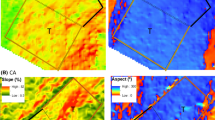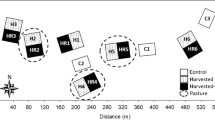Abstract
Soil respiration (RS) is one of the largest terrestrial sources of CO2 causing global warming and may vary according to land use and vegetation type. Türkiye is in the first place in the world in terms of area of hazelnut orchards that are generally converted from natural forests. The aim of this study was the comparison of the effects of cultural practices (pruning, fertilizing, and pruning+fertilizing) on RS in hazelnut orchards and that of the adjacent natural oak forest. Every trial site had a statistically similar annual mean RS, which ranged from 0.15 to 1.55 g C m−2 day−1. The RS on the sites was different only in the spring season and was similar in the other seasons. The RS of the pruned and fertilized hazelnut orchard (Hpf) in the spring was 58% greater than the unmaintained hazelnut orchard (Hc) and oak forest and 28% greater than the only fertilized hazelnut orchard (Hf). The RS of Hpf was also greater than other sites in most monthly measurements. While the positive correlation between soil moisture and RS was on an annual basis (r = 0.44), it was higher in summer (r = 0.61) and autumn (r = 0.55) seasons. The negative correlation between soil temperature and RS in the summer and autumn seasons evolved positively in winter. The results of the study suggest that the maintenance practices applied in the hazelnut garden could increase RS in the spring when soil moisture and temperature are optimal but have no effect in other seasons or on an annual basis.



Similar content being viewed by others
Data availability
All data generated or analyzed during this study are included in this published article.
References
Akburak, S., & Makineci, E. (2015). Effects of thinning on soil respiration and microbial respiration of forest floor and soil in an oak (Quercus frainetto) forest. Soil Research, 53(5), 522–530. https://doi.org/10.1071/SR14309
Bars, T. (2021). Fındık ürün raporu (Yayın No:340). Tarımsal Ekonomi ve Politika Geliştirme Enstitüsü, Ankara, Türkiye. https://arastirma.tarimorman.gov.tr/tepge/Belgeler/Yay%C4%B1n%20Ar%C5%9Fivi/2017-2022%20Yay%C4%B1n%20Ar%C5%9Fivi/Yay%C4%B1nno340.pdf. (in Turkish).
Bayraklı, B., Gülser, C., Özyazıcı, G., Özyazıcı, M. A., & Kesim, E. (2023). The effect of hazelnut husk applications on some properties of hazelnut orchard soil and hazelnut yield. Ege Üniversitesi Ziraat Fakültesi Dergisi, 60(3), 437–449.
Ceccon, C., Panzacchi, P., Scandellari, F., Prandi, L., Ventura, M., Russo, B., . . . Tagliavini, M. (2011). Spatial and temporal effects of soil temperature and moisture and the relation to fine root density on root and soil respiration in a mature apple orchard. Plant and Soil, 342(1), 195-206. https://doi.org/10.1007/s11104-010-0684-8
Çepel, N. (1971). Toprak yüzeyine varan yağış miktarına bitkilerin yaptığı etki ve Belgrad Ormanında yapılan bir araştırmaya ait beş yıllık sonuçlar. İÜ. Orman Fakültesi Dergisi, 11(2), 54–59 Article (in Turkish with an abstract in English).
Darenova, E., & Čater, M. (2018). Different structure of sessile oak stands affects soil moisture and soil CO2 efflux. Forest Science, 64(3), 340–348. https://doi.org/10.1093/forsci/fxx014
Demir, Z., & Işık, D. (2020). Using cover crops to improve soil quality and hazelnut yield. Fresenius Environmental Bulletin, 29(4), 1974–1987.
Ding, W., Cai, Y., Cai, Z., Yagi, K., & Zheng, X. (2007). Soil respiration under maize crops: effects of water, temperature, and nitrogen fertilization. Soil Science Society of America Journal, 71(3), 944–951. https://doi.org/10.2136/sssaj2006.0160
Edwards, N. (1982). The use of soda-lime for measuring respiration rates in terrestrial systems. Pedobiologia; (German Democratic Republic), 23, 321–330.
Green, C., & Byrne, K. A. (2004). Biomass: Impact on carbon cycle and greenhouse gas emissions. In C. J. Cleveland (Ed.), Encyclopedia of Energy (pp. 223–236). Elsevier. https://doi.org/10.1016/B0-12-176480-X/00418-6
Grogan, P. (1998). CO2 flux measurement using soda lime: Correction for water formed during CO2 adsorption. Ecology, 79(4), 1467–1468. https://doi.org/10.1890/0012-9658(1998)079[1467:CFMUSL]2.0.CO;2
Guner, S., Tufekcioglu, A., Gulenay, S., & Kucuk, M. (2016). Land-use type and slope position effects on soil respiration in black locust plantations in Artvin, Turkey. African Journal of Agricultural Research, 5(8), 719–724. https://doi.org/10.5897/AJAR09.771
Gülser, C., Kızılkaya, R., Askın, T., & Ekberli, I. (2015). Changes in soil quality by compost and hazelnut husk applications in a hazelnut orchard. Compost Science & Utilization, 23(3), 135–141.
Haynes, B. E., & Gower, S. T. (1995). Belowground carbon allocation in unfertilized and fertilized red pine plantations in northern Wisconsin. Tree Physiology, 15(5), 317–325. https://doi.org/10.1093/treephys/15.5.317
Inoue, T., & Koizumi, H. (2012). Effects of environmental factors upon variation in soil respiration of a Zoysia japonica grassland, central Japan. Ecological Research, 27(2), 445–452. https://doi.org/10.1007/s11284-011-0918-0
Irmak Yilmaz, F. (2020). Seasonal changes of some microbiological properties of soils in a field of hazelnut (Corylus avellana L.) growing. Applied Ecology and Environmental Research, 18, 253–262.
Keith, H., Jacobsen, K., & Raison, R. (1997). Effects of soil phosphorus availability, temperature and moisture on soil respiration in Eucalyptus pauciflora forest. Plant and Soil, 190(1), 127–141. https://doi.org/10.1023/A:1004279300622
Keith, H., & Wong, S. C. (2006). Measurement of soil CO2 efflux using soda lime absorption: Both quantitative and reliable. Soil Biology and Biochemistry, 38(5), 1121–1131. https://doi.org/10.1016/j.soilbio.2005.09.012
Kim, C. (2008). Soil CO2 efflux in clear-cut and uncut red pine (Pinus densiflora S. et Z.) stands in Korea. Forest Ecology and Management, 255(8), 3318–3321. https://doi.org/10.1016/j.foreco.2008.02.012
Kızıkaya, R., Dumbadze, G., Gülser, C., & Jgenti, L. (2022). Impact of NPK fertilization on hazelnut yield and soil chemical-microbiological properties of hazelnut orchards in Western Georgia. Eurasian Journal of Soil Science, 11(3), 206–215.
Kowalenko, C., & Ivarson, K. (1978). Effect of moisture content, temperature and nitrogen fertilization on carbon dioxide evolution from field soils. Soil Biology and Biochemistry, 10(5), 417–423. https://doi.org/10.1016/0038-0717(78)90068
Küçük, M. (2013). Farklı eğim ve bakı gruplarında bulunan meşe meşcerelerinde ve mera alanlarında azot mineralizasyonu ve toprak solunumunun belirlenmesi. [Doktora Tezi, Karadeniz Teknik Üniversitesi].
Lai, L., Zhao, X., Jiang, L., Wang, Y., Luo, L., Zheng, Y., . . . Rimmington, G. (2012). Soil respiration in different agricultural and natural ecosystems in an arid region. PloS one, 7, e48011. https://doi.org/10.1371/journal.pone.0048011
Lei, J., Guo, X., Zeng, Y., Zhou, J., Gao, Q., & Yang, Y. (2021). Temporal changes in global soil respiration since 1987. Nature Communications, 12(1), 1–9. https://doi.org/10.1038/s41467-020-20616-z
Lu, X., Wen, L., Sun, H., Fei, T., Liu, H., Ha, S., . . . Wang, L. (2022). Responses of soil respiration to phosphorus addition in global grasslands: A meta-analysis. Journal of Cleaner Production, 349, 131413. https://doi.org/10.1016/j.jclepro.2022.131413
MGM. (2022). Duzce meteorology station climate data (1959-2021). General Directorate of Meteorology Retrieved 25.07.2022 from https://www.mgm.gov.tr/veridegerlendirme/il-ve-ilceler-istatistik.aspx?k=A&m=DUZCE
Olajuyigbe, S., Tobin, B., Saunders, M., & Nieuwenhuis, M. (2012). Forest thinning and soil respiration in a Sitka spruce forest in Ireland. Agricultural and Forest Meteorology, 157, 86–95. https://doi.org/10.1016/j.agrformet.2012.01.016
Oral, H., Guney, M., Kucuker, M. A., Onay, T. T., Copty, N. K., Mater, B., & Yenigun, O. (2013). The impact of hazelnuts in land-use changes on soil carbon and in situ soil respiration dynamics. Journal of environmental management, 129, 341–349. https://doi.org/10.1016/j.jenvman.2013.07.014
Pacchiarelli, A., Priori, S., Chiti, T., Silvestri, C., & Cristofori, V. (2022). Carbon sequestration of hazelnut orchards in central Italy. Agriculture, Ecosystems & Environment, 333, 107955. https://doi.org/10.1016/j.agee.2022.107955
Ponder, F., Jr. (2005). Effect of soil compaction and biomass removal on soil CO2 efflux in a Missouri forest [Article]. Communications in Soil Science and Plant Analysis, 36(9-10), 1301–1311. https://doi.org/10.1081/CSS-200056935
Raich, J. W., Potter, C. S., & Bhagawati, D. (2002). Interannual variability in global soil respiration, 1980–94. Global Change Biology, 8(8), 800–812. https://doi.org/10.1046/j.1365-2486.2002.00511.x
Raich, J. W., & Tüfekçioğlu, A. (2000). Vegetation and soil respiration: Correlations and controls. Biogeochemistry, 48(1), 71–90. https://doi.org/10.1023/A:1006112000616
Rey, A., Pegoraro, E., Tedeschi, V., De Parri, I., Jarvis, P. G., & Valentini, R. (2002). Annual variation in soil respiration and its components in a coppice oak forest in Central Italy. Global Change Biology, 8(9), 851–866. https://doi.org/10.1046/j.1365-2486.2002.00521.x
Samuelson, L., Mathew, R., Stokes, T., Feng, Y., Aubrey, D., & Coleman, M. (2009). Soil and microbial respiration in a loblolly pine plantation in response to seven years of irrigation and fertilization. Forest Ecology and Management, 258(11), 2431–2438.
Sargıncı, M., Arslan, H., Dönmez, A. H., & Temur, Ş. (2017). Effects of aspect on some soil properties in oak and beech-hornbeam forest in Western Black Sea Region of Turkey. International symposium on new horizons in forestry.
Singh, J., & Gupta, S. (1977). Plant decomposition and soil respiration in terrestrial ecosystems. The botanical review, 43(4), 449–528. https://doi.org/10.1007/BF02860844
Staelens, J., De Schrijver, A., & Verheyen, K. (2007). Seasonal variation in throughfall and stemflow chemistry beneath a European beech (Fagus sylvatica) tree in relation to canopy phenology. Canadian Journal of Forest Research, 37(8), 1359–1372. https://doi.org/10.1139/X07-003
Tüfekçioğlu, A., & Küçük, M. (2004). Soil respiration in young and old oriental spruce stands and in adjacent grasslands in Artvin, Turkey. Turkish Journal of Agriculture and Forestry, 28(6), 429–434.
Tüfekçioğlu, A., Özbayram, A. K., & Küçük, M. (2009). Soil respiration in apple orchards, poplar plantations and adjacent grasslands in Artvin, Turkey. Journal of Environmental Biology, 30(5), 815–820.
Unver, M. C., Kucuk, M., & Tufekcioglu, A. (2016). Influence of land use type on soil respiratıon rates in Artvin, Turkey. Oxidation Communications, 39(1), 413–420.
Vanhala, P. (2002). Seasonal variation in the soil respiration rate in coniferous forest soils. Soil Biology and Biochemistry, 34(9), 1375–1379. https://doi.org/10.1016/S0038-0717(02)00061-5
Wenjie, W., Wei, L., Wei, S., Yuangang, Z., & Song, C. (2008). Influences of forest floor cleaning on the soil respiration and soil physical property of a larch plantation in Northeast China. Acta Ecologica Sinica, 28(10), 4750–4756. https://doi.org/10.1016/S1872-2032(09)60004-4
Yaltirik, F. (1984). Türkiye meşeleri teşhis kılavuzu (The oak trees of Turkey). Tarım orman ve köyişleri bakanlığı genel müdürlüğü yayınevi, 64 p., Article (in Turkish with an abstract in English).
Yang, Y., Li, T., Pokharel, P., Liu, L., Qiao, J., Wang, Y., et al. (2022). Global effects on soil respiration and its temperature sensitivity depend on nitrogen addition rate. Soil Biology and Biochemistry, 174, 108814. https://doi.org/10.1016/j.soilbio.2022.108814
Yılmaz, F. (2014). Doğu kayını (Fagus orientalis lipsky) meşcerelerinde aralamanın yağışın dispozisyonu ve bazı su kalitesi parametrelerine etkileri. [Doktora Tezi, Düzce Üniversitesi].
Zheng, D., Chen, J., LeMoine, J. M., & Euskirchen, E. S. (2005). Influences of land-use change and edges on soil respiration in a managed forest landscape, WI, USA. Forest Ecology and Management, 215(1), 169–182. https://doi.org/10.1016/j.foreco.2005.05.011
Acknowledgements
I would like to thank my colleagues (Ömer Er, Furkan T. Lapanta, Burak Kaba, Yunus E. Danışmaz, Furkan Aslaner, İslam C. İpek) who helped me in the field studies.
Author information
Authors and Affiliations
Contributions
Ali Kemal Özbayram: data collection, prepared tables and figures, wrote the main manuscript, review and editing.
Corresponding author
Ethics declarations
Ethical approval
Unethical actions were not made. Author has read, understood, and has complied as applicable with the statement on “Ethical responsibilities of Authors” as found in the Instructions for Authors.
Competing interests
The author declares no competing interests.
Additional information
Publisher’s Note
Springer Nature remains neutral with regard to jurisdictional claims in published maps and institutional affiliations.
Rights and permissions
Springer Nature or its licensor (e.g. a society or other partner) holds exclusive rights to this article under a publishing agreement with the author(s) or other rightsholder(s); author self-archiving of the accepted manuscript version of this article is solely governed by the terms of such publishing agreement and applicable law.
About this article
Cite this article
Özbayram, A.K. Effects of cultural practices on soil respiration in hazelnut orchards and a comparison with an adjacent natural oak forest. Environ Monit Assess 196, 287 (2024). https://doi.org/10.1007/s10661-024-12450-3
Received:
Accepted:
Published:
DOI: https://doi.org/10.1007/s10661-024-12450-3




